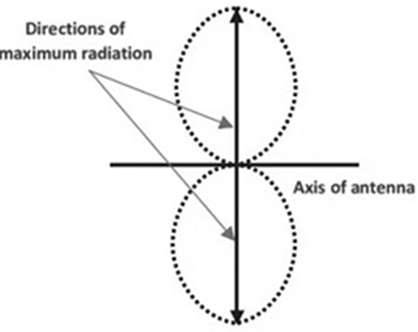- It is a type of RF antenna that includes two conductive elements like wires or rods where the metal wire length is half of the highest wavelength approximately in free space at the operation of frequency.
- At the center of the antenna, the conductive materials are separated through an insulator which is called an antenna section.

- In The middle of the antenna the RF voltage source is given then the voltage & current supplied throughout the two conductive elements generate an electromagnetic or radio signal and this signal is radiated outside of the antenna.
- If the voltage is minimum and current is maximum then it is a central part whereas the voltage is maximum & current is minimum at the dipole antenna’s two ends.
Working of Dipole Antenna
- The RF voltage source is applied to the center of the two sections in the antenna then the flow of voltage & current throughout the two conductive elements can generate an electromagnetic or radio wave signal to be radiated outside of the antenna.
- The voltage is minimum and the current is maximum if the voltage source is applied at the center of the antenna.
- The current is minimum & the voltage is maximum at the antenna’s ends. This is the current distribution of the dipole antenna.
- The dipole antenna radiation pattern diagram is shown below which is vertical to the axis of the antenna.

Types of Dipole Antenna
Different types of dipole antennas available are used in different application.
- Half-wave Dipole Antenna
- Folded Dipole Antenna
- Short Dipole Antenna
- FM Dipole Antenna
- Fan Dipole Antenna
Wavelength of Dipole Antenna
- The wavelength of an antenna can be calculated from the frequency formula.
Frequency (f) = C/λ - From the above equation, the wavelength can be derived
λ = C/f - Where:
‘C’ is the light speed.
‘f’ is the frequency.
Advantages of Dipole Antenna
- The simplicity is the main advantage of this antenna.
- These are extremely efficient once used at the resonant frequency.
- The gap sizes of dipole don’t impact the antenna’s performance.
- These are Omni directional while transmitting & receiving signals.
- As compared to telescoping monopole antenna, telescoping dipoles allow you to get a wider frequency range.
- The radiation pattern of this antenna is donut-shaped by the antenna sitting within the center of the hole.
- These antennas are simple to design and install in different configurations like sloping, drooping, inverted V, etc.
- Any signal can be received almost without worrying about its direction.
- These antennas can be reduced & resonated with a loading coil. When this coil is arranged in the center then we can get good results.
Disadvantages of Dipole Antenna
- The wavelength is long for very less frequencies to make an antenna.
- Folded-type antennas are somewhat complicated as compared to monopole antennas, although they are not complicated as the quad patch or yagi UDA antennas.
- For below 27 MHz frequencies, the antenna’s efficiency will start reducing when the length of the antenna decreases.
- As compared to a typical antenna, the efficiency of Inverted-V type antennas has reduced.
- The size of indoor antennas is very small as compared to outdoor.
- Outdoor antennas are large, so installing and transporting are very difficult to handle.
Applications of Dipole Antenna
- These antenna is used in different areas where they can form the radiating element.
- This antenna is used in radio & telecommunications.
- The dipole antenna is used in two-way communication.
- A half-wave type antenna can be used in TV & radio receivers.
- A dipole antenna is used in radio astronomy, satellite communications & several types of radio communication links.
- VHF & UHF type antennas are mainly used in land mobile communication within public safety, coastal areas, and industrial & public communication applications.
